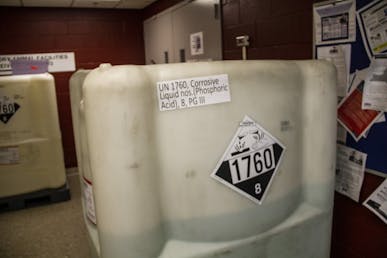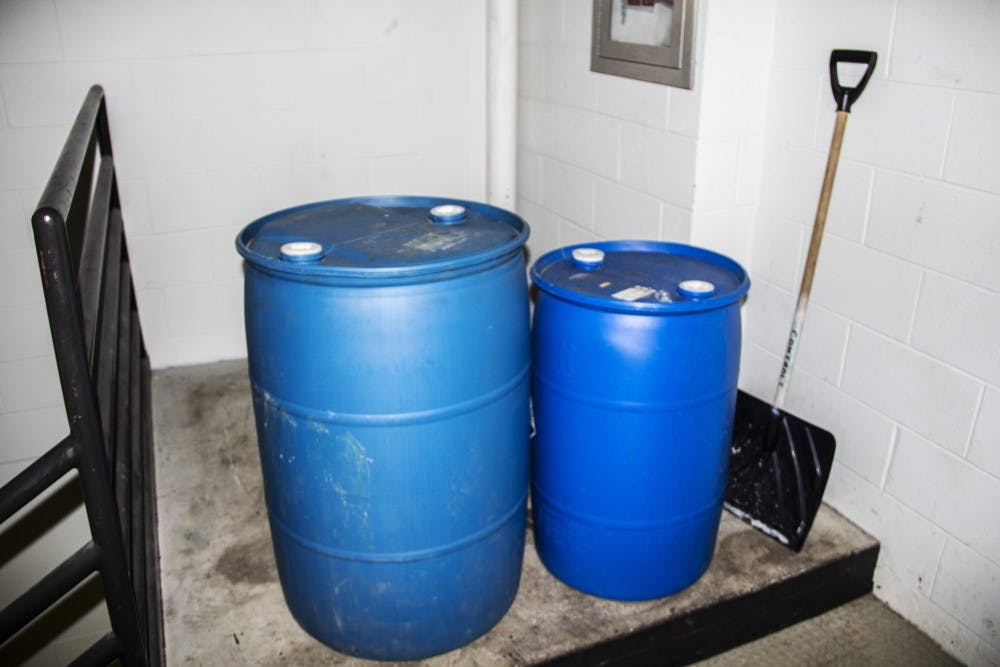The Spectrum found four hazardous waste containers on South Campus, three months after a state audit report criticized the university for its hazardous materials storage. The containers were in the Biomedical Education Building in areas accessible to students and the public late Friday afternoon.
The containers were still there at 9:30 a.m. on Monday.
The audit report, in December, called UB’s materials “vulnerable to mismanagement at the very least.”
The containers, one filled with liquid and three empty, were labeled “corrosive” and sat on the first and fourth floors near UB’s anatomical gift and animal research labs on South Campus. The Spectrum did not find UB-generated hazardous waste labels or general trash disposal labels on the four containers, despite UB’s “eight golden rules” on waste accumulation in its hazardous waste guidebook.
A New York State Department of Health employee, who declined to provide a name for fear of being fired, called the storage situation “concerning.”
“There should be periodic inspections by whomever oversees health and safety on campus,” the DOH employee said. “I come out of a university environment and this did not follow label requirements or storage requirements.”
Two of the empty, blue and barrel-like containers had a label from Buffalo Industrial Chemicals, Inc. They stood on the top floor stairwell and emitted an odor strong enough to make reporters cover their noses as they approached. The odor permeated the top floor stairwell and reached the floor below.
The two white containers were somewhat translucent and could hold approximately 200 gallons. One was labeled “Acid Power” and was half-filled with a liquid. It did not smell and was on the first floor behind a door labeled “Restricted Access.” Spectrum reporters pushed on the door and it opened on Friday and Monday. The other was labeled “ALKA-DET 3,” a cage-washing sanitizer. Labels warned contact “causes severe skin burns and eye damage.”
The Spectrum contacted UB Environmental Health and Safety Monday after reporters verified UB had not relocated the containers.

EHS Associate Director David Vasbinder said staff removed and relocated the three empty containers to “appropriate storage areas” by Tuesday morning.
The “Acid Power” container, the one with the liquid, was not there when EHS searched the building on Monday afternoon, Vasbinder wrote in an email. A lab animal facility worker who works on South Campus told The Spectrum that workers moved the container, which he called “soap” to wash cages, into a locked facility on Monday morning. Phosphoric acid was the main ingredient on the label of the container containing liquid. Vasbinder said the cage-washing liquids were similar to household cleaners and disinfectants.
The empty blue containers, he said, had contained ethylene glycol, which is found in antifreeze and was used for the building’s heating loops. The barrels originally contained “formula 1251,” a product used “in specific types of cooling water circuits,” according to a safety data sheet. UB had washed the containers and refilled them with ethylene glycol, according to Vasbinder.
“However, previous labels on these [containers] were not removed or defaced as should have been done,” Vasbinder said.
Ethylene glycol was “removed from the heat transferring system, put into barrels then fed back into the system” at the building. Vasbinder wrote that UB Facilities used the containers.
He said EHS “detected a slight smell at the top of the stairwell” on Monday and the containers “were empty and had bung caps in place that keep them sealed.”
He said there may have been ”some of the characteristic sweet odor from residual ethylene glycol, which would not have posed a health threat to individuals using the stairwell,”
UB’s EHS has “eight golden rules” that state UB employees must stamp a UB-generated “hazardous waste” label on a container when it comes to campus. Employees also need to fill out a UB general trash disposal label for container disposals. The Spectrum did not find any UB-generated container labels on Friday and Monday.
The Spectrum’s findings come three months after the state comptroller’s office reported “limited assurance that only authorized people have access to [UB] areas storing hazardous materials” and UB was “not open or responsive to the risk raised” by auditors. UB, in a written response to the report, said OSC’s report was “incorrect and misleading,” having the “potential to needlessly alarm our students, employees and campus communities.”
The Spectrum reached out to OSC, but a spokesperson declined to speak on matters outside the audit.
“[EHS] … will be reviewing proper storage of empty containers and proper labeling of containers for secondary purposes and to indicate the empty conditions,” Vasbinder wrote.
How The Spectrum found the containers
On Friday, two Spectrum reporters working on a story unrelated to hazmat walked into the BEB and smelled a nausea-inducing odor. The reporters saw the containers and investigated. According to a safety data sheet, the product labeled on the barrel was “for industrial use only” and it should be in “locked up” storage.
Vasbinder wrote that the stairwell landing “is not normally accessed unless someone with key access is going to the roof.” The reporters walked up the stairs without encumbrance.
Spectrum reporters also found two white containers on the BEB’s first floor. The containers were labelled with a Pharmacal Research Laboratories, Inc. logo.
The doors leading up to the containers were unlocked and open to the public, once on Friday and again on Monday morning.
Vasbinder wrote that the location was a “restricted area” and “not a direct path through a building nor is it a public access corridor.”
One container, labelled “phosphoric acid,” is sold as “Acid Power” on Pharmacal’s website. The other container, labelled “potassium hydroxide,” is sold as “ALKA-DET 3.” GHS classifies the contents of “Acid Power” and “ALKA-DET 3” as “serious” and “severe” for skin and eye exposure. Vasbinder wrote that the “ALKA-DET 3” container “did have a label which reflected the previous contents but there was no additional labeling to indicate that it was empty.”
David Niederbuhl, facility manager at the Comparative Medicine Laboratory Animal Facilities, said the white containers’ location on Monday is not where the lab usually places them.
“We were storing them there for a short period of time, one of them was actually empty and we were waiting for the [other] tank to be emptied to [another] facility,” Niederbuhl said on Tuesday morning.
Niederbuhl said the containers’ storage location was not regular practice and the containers are “typically” inside of the facility behind a set of closed doors. The doors by the containers should have been shut, he said.
“We put the full [container] in our facility and the empty one is out by the loading dock for [Newton] freight company to pick up,” Niederbuhl said on Tuesday morning.
He said the company was “supposed to pick up” the empty container on Monday, but he was in downtown Buffalo, so he could not confirm its status on Tuesday morning.
Vasbinder wrote in a statement that UB takes its obligations to provide a safe and secure environment “very seriously.”
“We will continue to uphold our rigorous standards to ensure a safe campus environment,” Vasbinder wrote. “[EHS] will continue to communicate with any departments using bulk chemicals to ensure that they are aware of restrictions on storage of full or empty containers in public corridors and stairwells.”
Vasbinder wrote that EHS holds safety training sessions for campus chemical users and reminds training attendees about “proper container labeling and storage practices.”
Correction: A previous version of this story said that the state audit report criticized UB for its "hazardous waste storage," when it should have stated "hazardous materials storage."
Benjamin Blanchet and Thomas Zafonte are editors and can be reached at benjamin.blanchet@ubspectrum.com and thomas.zafonte@ubspectrum.com and on Twitter @BenjaminUBSpec and @Thomas_Spectrum.

Benjamin Blanchet is the senior engagement editor for The Spectrum. His words have been seen in The Buffalo News (Gusto) and The Sun newspapers of Western New York. Loves cryptoquip and double-doubles.
Thomas Zafonte is a senior English major. He is a UB sports fan and enjoys traveling around Buffalo.






